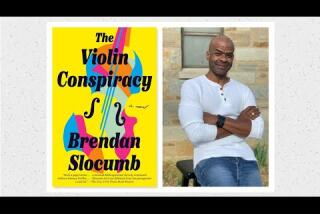The String Section
- Share via
In the best-selling novel “Cold Mountain,” the deserter Stobrod fashions himself a fiddle while awaiting the end of the Civil War. He shapes it from memory, collects the wood from the surrounding forest, boils the glue from the hooves of a deer and steals the varnish. Inside the sound box, he fastens a rattlesnake’s tail.
This is not how Stradivari did it.
Nor were these the ways of all early American violin makers. But the depiction is sufficiently representative to explain the historic disregard accorded American luthiers of the 19th and early 20th centuries. So bad was their reputation that a well-made American violin of the era might fetch only a twentieth the price of a European equivalent, and the best examples were often relabeled and sold as Italian.
But all this is changing. Many of today’s makers have had years of formal training. Modern travel has enabled the easy study of old masterpieces. And a newfound ability to command top prices (as high in some cases as $25,000 for a new instrument) has made possible the luxuries of time and the opportunity for artistic latitude. The result, says Thomas Wenberg, author of “The Violin Makers of the United States,” is that Americans are now making “the finest violins that have ever been made.”
Published in 1986, Wenberg’s book was a first. To write it, he spent three years on the road, living in the back of a pickup truck and compiling data on the lives and work of more than 3,000 luthiers.
Another champion of the American violin is Todd French, a cellist with the Los Angeles Opera and Long Beach Symphony and head of the newly formed Musical Instruments Department at Butterfield & Butterfield’s Los Angeles auction house. To help kick off the firm’s first major auction of fine musical instruments on Feb. 9, French is highlighting among the 200 items to be sold a special collection of some 30 early American violins.
French will precede the auction with an exhibition of American violin and bow makers beginning on Saturday. Nearly 50 of America’s best contemporary makers will be in attendance, offering players and public a rare opportunity to view a large and diverse array of new instruments, ranging in style from modern renditions of traditional Italian models to Christophe Landon’s famous asymmetric blue violin.
There will be an equally rare chance on Monday to hear Wenberg. He has become a state senator in Oregon, where he’s more likely to speak of salmon recovery plans than of violins.
Hours are 10 a.m. to 5 p.m. Saturday, noon to 5 p.m. Feb. 8 and 9 a.m. to 1 p.m. Feb. 9. Wenberg will speak at 10 a.m. Feb. 9. 7601 Sunset Blvd., Los Angeles. Admission is free.
More to Read
The biggest entertainment stories
Get our big stories about Hollywood, film, television, music, arts, culture and more right in your inbox as soon as they publish.
You may occasionally receive promotional content from the Los Angeles Times.










